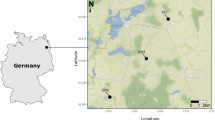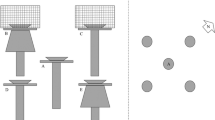Abstract
Current evidence suggests regular overland transport of different freshwater invertebrates by wind, mainly over short distances. Yet, very little is known about the mechanism and scale of this process or about differences in wind dispersal dynamics and capacities among taxa and propagule types. We investigated wind dispersal of freshwater invertebrates in a cluster of temporary rock pools (spatial scale: 9,000 m2) in South Africa. Dispersing propagules and propagule bank fragments (i.e. aggregates of sediments and propagules) were intercepted during 1 month using a combination of windsocks (1.5 m above ground level) and sticky traps (ground level). The potential movement of propagule bank fragments (i.e. aggregates of propagules and sediments) was also simulated by tracking inter-pool movements of differently sized artificial substrate fragments similar to dry propagule bank fragments. We detected differences in the composition of dispersing communities intercepted at different altitudes (ground level and at 1.5 m). Comparison of dispersal distance distributions also revealed significant differences among taxa. Overall, larger propagule types (e.g. adult ostracods and oribatid mites) dominantly travelled near ground level while small resting eggs and cryptobiotic life stages of copepods were most frequently collected at higher altitudes (1.5 m) and dispersed over the longest distances. Finally, not only dispersal of single propagules but also ground level transport of propagule bank fragments was shown to contribute to local dispersal dynamics in temporary aquatic habitats.




Similar content being viewed by others
References
Amarasekare, P., 2004. Spatial variation and density-dependent dispersal in competitive coexistence. Proceedings of the Royal Society of London Series B-Biological Sciences 271: 1497–1506.
Bohonak, A. J. & H. H. Whiteman, 1999. Dispersal of the fairy shrimp Branchinecta coloradensis (Anostraca): effects of hydroperiod and salamanders. Limnology and Oceanography 44: 487–493.
Brendonck, L. & L. De Meester, 2003. Egg banks in freshwater zooplankton: evolutionary and ecological archives in the sediment. Hydrobiologia 491: 65–84.
Brendonck, L. & B. J. Riddoch, 1999. Wind-borne short-range egg dispersal in anostracans (Crustacea: Branchiopoda). Biological Journal of the Linnean Society 67: 87–95.
Caceres, C. E. & D. A. Soluk, 2002. Blowing in the wind: a field test of overland dispersal and colonization by aquatic invertebrates. Oecologia 131: 402–408.
Chaplin, J. A. & D. J. Ayre, 1997. Genetic evidence of widespread dispersal in a parthenogenetic freshwater ostracod. Heredity 78: 57–67.
Cohen, G. M. & J. B. Shurin, 2003. Scale-dependence and mechanisms of dispersal in freshwater zooplankton. Oikos 103: 603–617.
Esri, 2002. ARCGIS 8.1. ESRI, Redlands, California.
Frisch, D. & A. J. Green, 2007. Copepods come in first: rapid colonization of new temporary ponds. Fundamental and Applied Limnology 168: 289–297.
Frisch, D., A. J. Green & J. Figuerola, 2007. High dispersal capacity of a broad spectrum of aquatic invertebrates via waterbirds. Aquatic Sciences 69: 568–574.
Graham, T. B. & D. Wirth, 2008. Dispersal of large branchiopod cysts: potential movement by wind from potholes on the Colorado Plateau. Hydrobiologia 600: 17–27.
Green, A. J. & J. Figuerola, 2005. Recent advances in the study of long-distance dispersal of aquatic invertebrates via birds. Diversity and Distributions 11: 149–156.
Greene, D. F. & M. Quesada, 2005. Seed size, dispersal, and aerodynamic constraints within the Bombacaceae. American Journal of Botany 92: 998–1005.
Jenkins, D. G. & A. L. Buikema, 1998. Do similar communities develop in similar sites? A test with zooplankton structure and function. Ecological Monographs 68: 421–443.
Jenkins, D. G. & M. O. Underwood, 1998. Zooplankton may not disperse readily in wind, rain, or waterfowl. Hydrobiologia 388: 15–21.
Jocqué, M., K. Martens, B. Riddoch & L. Brendonck, 2006. Faunistics of ephemeral rock pools in southeastern Botswana. Archiv für Hydrobiologie 165: 415–431.
Louette, G. & L. De Meester, 2005. High dispersal capacity of cladoceran zooplankton in newly founded communities. Ecology 86: 353–359.
Mayr, E., 1963. Animal Species and Evolution. Belknap Press of Harvard University Press, Cambridge.
Meyer, S. E. & S. L. Carlson, 2001. Achene mass variation in Ericameria nauseosus (Asteraceae) in relation to dispersal ability and seedling fitness. Functional Ecology 15: 274–281.
Michels, E., K. Cottenie, L. Neys & L. De Meester, 2001. Zooplankton on the move: first results on the quantification of dispersal of zooplankton in a set of interconnected ponds. Hydrobiologia 442: 117–126.
Minami, S. & A. Azuma, 2003. Various flying modes of wind-dispersal seeds. Journal of Theoretical Biology 225: 1–14.
Nathan, R., G. Perry, J. T. Cronin, A. E. Strand & M. L. Cain, 2003. Methods for estimating long-distance dispersal. Oikos 103: 261–273.
Nathan, R., N. Sapir, A. Trakhtenbrot, G. G. Katul, G. Bohrer, M. Otte, R. Avissar, M. B. Soons, H. S. Horn, M. Wikelski & S. A. Levin, 2005. Long-distance biological transport processes through the air: can nature’s complexity be unfolded in silico? Diversity and Distributions 11: 131–137.
Pajunen, V. I., 1986. Distributional dynamics of Daphnia species in a rock-pool environment. Annales Zoologici Fennici 23: 131–140.
Panov, V. E. & C. E. Cáceres, 2007. Role of diapause in dispersal of aquatic invertebrates. In Alekseev, V. & B. De Stasio (eds), Diapause in Aquatic Invertebrates: Role for Ecology, Physiology and Human Uses. Springer, Dordrecht.
Panov, V. E., P. I. Krylov & N. Riccardi, 2004. Role of diapause in dispersal and invasion success by aquatic invertebrates. Journal of Limnology 63(Suppl. 1): 56–69.
Salisbury, E., 1975. Survival value of modes of dispersal. Proceedings of the Royal Society of London Series B-Biological Sciences 188: 183–188.
Statsoft, 2007. STATISTICA (data analysis software system). Statsoft inc., Tulsa, Oklahoma.
Van de Meutter, F., R. Stoks & L. de Meester, 2008. Size-selective dispersal of Daphnia resting eggs by backswimmers (Notonecta maculata). Biology Letters 4: 494–496.
Vanschoenwinkel, B., C. De Vries, M. Seaman & L. Brendonck, 2007. The role of metacommunity processes in shaping invertebrate rock pool communities along a dispersal gradient. Oikos 116: 1255–1266.
Vanschoenwinkel, B., S. Gielen, M. Seaman & L. Brendonck, 2008a. Any way the wind blows – frequent wind dispersal drives species sorting in ephemeral aquatic communities. Oikos 117: 125–134.
Vanschoenwinkel, B., S. Gielen, H. Vandewaerde, M. Seaman & L. Brendonck, 2008b. Relative importance of different dispersal vectors for small aquatic invertebrates in a rock pool metacommunity. Ecography 31: 567–577.
Vanschoenwinkel, B., A. Waterkeyn, T. Vandecaetsbeek, O. Pineau, P. Grillas & L. Brendonck, 2008c. Dispersal of freshwater invertebrates by large terrestrial mammals: a case study with wild boar (Sus scrofa) in Mediterranean wetlands. Freshwater Biology 53: 2264–2273.
Williams, D. D., 2006. The Biology of Temporary Waters. Oxford University Press, London: 337 pp.
Willson, M. F. & A. Traveset, 2000. The ecology of seed dispersal. In Fenner, M. (ed.), Seeds: The Ecology of Regeneration in Plant Communities. CAB International, Wallingford: 85–110.
Acknowledgements
Bram Vanschoenwinkel was supported by the Fund for scientific research Flanders (FWO). We thank Mr. Danie Vorster, Oom Thys and Annelize Strydom, for logistic support and access to the site and Ine Beyen for help in the field. We are grateful to Ria Van Houdt and Stef Usé for their contribution to the design and manufacturing of the windsocks. This research is financially supported by project G.0118.03 of the FWO (Fund for scientific research Flanders).
Author information
Authors and Affiliations
Corresponding author
Additional information
Handling editor: B. Oertli
Rights and permissions
About this article
Cite this article
Vanschoenwinkel, B., Gielen, S., Seaman, M. et al. Wind mediated dispersal of freshwater invertebrates in a rock pool metacommunity: differences in dispersal capacities and modes. Hydrobiologia 635, 363–372 (2009). https://doi.org/10.1007/s10750-009-9929-z
Received:
Revised:
Accepted:
Published:
Issue Date:
DOI: https://doi.org/10.1007/s10750-009-9929-z




